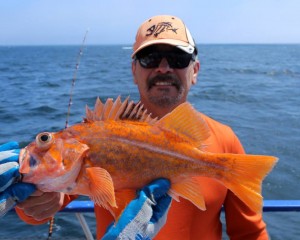Barotrauma
What is barotrauma and why do rockfish suffer from it?
Barotrauma is the injury to certain organs after experiencing a change in pressure. Rockfish experience barotrauma as they are caught and reeled to the surface. The gasses within their swim bladder and other organs expand with the change in pressure. Often you will see a rockfish with the stomach protruding from it’s mouth, eyes bulging, and gas bubbles in the eyes, under the skin or near the gills. These are all symptoms of barotrauma. When a rockfish suffering from barotrauma is released at the surface it is too buoyant and can’t swim down on it’s own. “Floaters” often become prey for a passing gull or marine mammal or eventually succumb to their injuries. But here’s the good news!….
Even fish with barotrauma that appear lifeless at the surface can survive! Long-term tagging studies show high survival of fish that are quickly re-pressurized and released back at depth (even in deep water!). Descending devices work great for getting those “floaters” back to the bottom! Check out some of our video where you can see the fish being re-pressurized and swim away.
That’s not the swim bladder protruding from this Gopher’s mouth, it’s actually the stomach! We discourage poking (also called venting) of the stomach which causes additional injury. Keep this fish to eat or get it quickly back down to depth with a descending device!

The expansion of gasses in the swim bladder of this Brown Rockfish have pushed the stomach out through the fish’s mouth.
Canary Rockfish are required to be released under current regulations. This Canary is suffering from barotrauma, as shown by the bulging eyes. It will make a quick recovery if re-pressurized and released on a descending device right away. No more floaters!
Watch the Canary pictured above be released back at depth with a Shelton Fish Descender

